Lack of Icebreaking Hampers Great Lakes Shipping
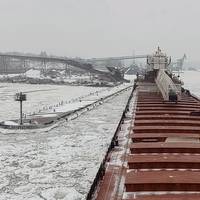
A lack of Coast Guard icebreaking assets is hampering U.S.-flag shipping on the Great Lakes, according to industry coalition the Great Lakes Maritime Task Force.“The inefficiency introduced into the Great Lakes Navigation System by inadequate Coast Guard icebreaking resources impacts the carriers, their customers and the entire North American Manufacturing supply chain,” said Jim Weakley, President of Great Lakes Maritime Task Force, and the Lake Carriers’ Association. “The men and women of the U.S. Coast Guard do the best they can with the resources they are provided.
Icebreaking Kicks Off on the Great Lakes
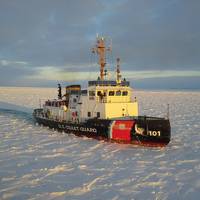
It's that time of year.The US Coast Guard announced it has commenced icebreaking operations in response to expanded ice growth in the commercial ports of western Lake Superior.Operation Taconite, launched by Coast Guard Sector Sault Sainte Marie on Wednesday, is one of two icebreaking operations that support the Great Lakes. It encompasses Lake Superior, St. Marys River, Straits of Mackinac, Georgian Bay, Green Bay, northern Lake Huron, and Lake Michigan.The authority for Coast Guard domestic icebreaking was created in 1936, by Executive Order 7521 signed by President Franklin D.
USCG Begins Icebreaking in the Western Great Lakes

U.S. Coast Guard Sector Sault Sainte Marie has commenced icebreaking Operation Taconite in response to expanded ice growth in the commercial ports of western Lake Superior and the lower St. Marys River. Before ice impedes commercial navigation, icebreakers were assigned to each region. U.S. Coast Guard Cutter Alder was assigned to manage the ice breaking needs of western Lake Superior, specifically the twin ports of Duluth, Minn., and Superior, Wisc., as well as the Port of Thunder Bay, Ont. U.S. Coast Guard Cutter Biscayne Bay was assigned to the St. Marys River.
Cargo Ship Runs Aground in Saint Marys River
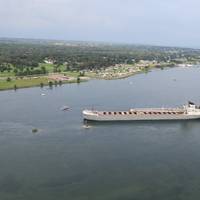
The St. Marys River is closed to commercial vessels from the Soo Locks to 6 Mile Point, after a 629-foot U.S. cargo ship ran aground on the north side of Sugar Island, Wednesday, at about 11:40 p.m. The merchant vessel, Calumet, departed Essar Steel in Sault Ste. Marie, Ont. and was transiting downbound on the St. Marys River to its next port of call in Brevort, Mich., when it ran aground. The vessel was not carrying any cargo. There was no pollution, and no injuries have been reported. The U.S. Coast Guard is monitoring the vessel, and the U.S.
Ice breaking Begins in Great Lakes
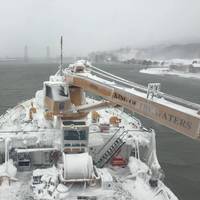
U.S. Coast Guard Sector Sault Sainte Marie commenced Operation Taconite Monday in response to developing ice conditions in the commercial ports of western Lake Superior and the St Marys River. Operation Taconite is the Coast Guard’s largest domestic ice-breaking operation, encompassing Lake Superior, the St. Mary’s River, the Straits of Mackinac and Lake Michigan. As a result of the operation, certain waterways may close after due consideration is given to the protection of the marine environment…
USCG Cutter Biscayne Bay Hauled Out
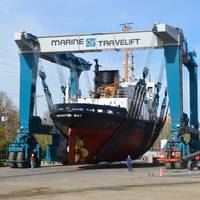
Great Lakes Shipyard hauled out the United States Coast Guard Cutter Biscayne Bay using its 770-ton capacity Travelift. This is the second of the USCG’s six (6) Great Lakes stationed 140-foot Bay Class ice breaking tugs to be drydocked using Great Lakes Shipyard’s new Marine Travelift. The Shipyard’s Travelift has also been used to lift one of the 150-foot Buoy Barges pushed by the Bay Class Tugs, and the USCGC Buckthorn, stationed in Sault Ste. Marie, Michigan. The Travelift is the largest on the Great Lakes in the United States and Canada…
Coast Guard Cutter Gets a Lift Ashore in Cleveland
The U.S. Coast Guard Cutter 'Biscayne Bay', a 140-foot ice-breaking tug homeported in St. Ignace, Mich., was lifted out of Lake Erie for routine maintenance in the Great Lakes Shipyard in Cleveland. The Coast Guard explains that the Biscayne Bay was lifted from the water by a 770-ton 'Travelift.
Coast Guard Cutter, Bulk Carrier Collide on Lake Michigan
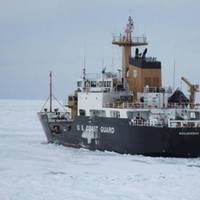
The U.S. Coast Guard reported that Cutter Hollyhock, a 225-foot seagoing buoy tender homeported in Port Huron, Mich., was involved in a collision with a 990-foot bulk carrier in northern Lake Michigan Sunday morning. The Hollyhock was conducting an ice escort at the time of the collision. At about 10:45 a.m., the Hollyhock was breaking ice in front of the motor vessel Mesabi Miner during when the collision occurred. The cutter's crew reported significant damage to the stern and fantail, as well as two punctures in the hull about 20 feet above the waterline.





